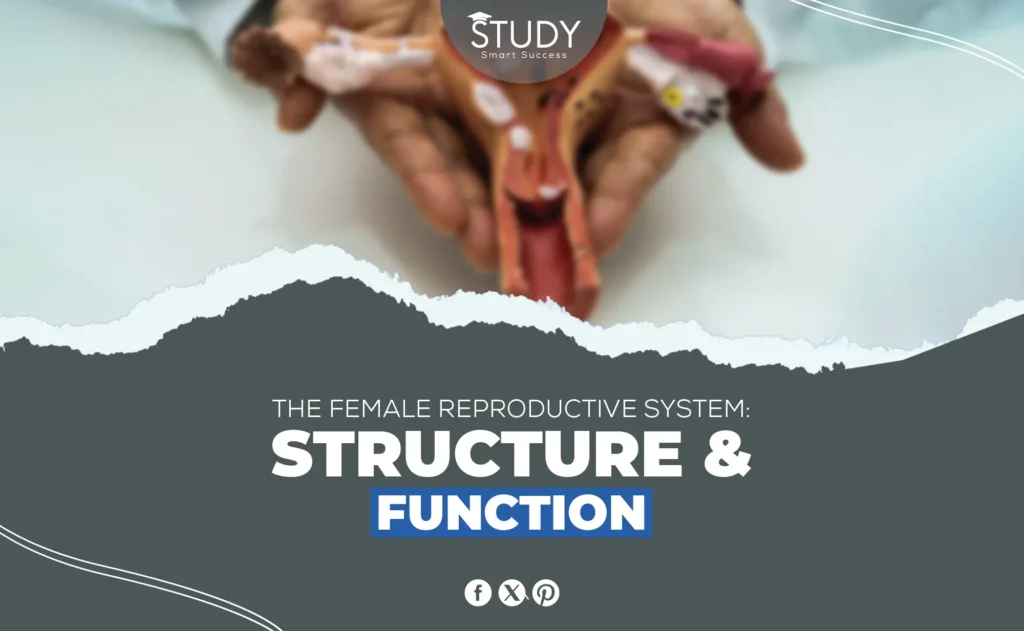Introduction
A woman’s reproductive system comprises many complex and specialized organs and cells needed to have children. It not only allows eggs to be made but also creates the right conditions for fertilization, pregnancy, and birth. Understanding how the female reproductive system is put together and how it works is essential for women’s health.
With this information, women can monitor their reproductive health, spot problems early, and make well-informed choices about their bodies. In addition, anyone working in healthcare, education, or parenting needs to know the basics of this method to help better and guide others.
Primary Components of the Female Reproductive System
Ovaries
Small, almond-shaped ovaries are positioned on either side of the uterus in the pelvic cavity. Both organs are essential to the female reproductive system because they produce eggs (oogenesis). Estrogen and progesterone are released by the ovaries together with eggs. These hormones regulate the menstrual cycle, prepare the body for pregnancy, and encourage breast development and menstrual regulation.
Fallopian Tubes
Narrow, tubular fallopian tubes connect the ovaries to the upper uterus. Each fallopian tube is 10-12 cm long and vital to reproduction. The primary purpose of fallopian tubes is to deliver the egg from the ovary to the uterus. Cilia lining the tubes help this travel. Usually, sperm fertilize eggs in the fallopian tubes.
Uterus
The pelvic uterus is hollow and muscular, between the bladder and rectum. Its narrow end points downward, often described as pear-shaped. The endometrium, myometrium, and perimetrium make up the uterus. During the menstrual cycle, the endometrium changes to prepare for pregnancy. If fertilization happens, the embryo implants in the endometrium and is fed throughout pregnancy. The myometrium causes intense labor contractions that deliver the baby.
Cervix
The slender, lower cervix forms a passage between the uterus and the vagina. It plays various vital roles in female reproduction. Menstrual blood flows from the uterus to the vagina through the cervix. The cervix generates mucus to guide sperm into the uterus during ovulation. The cervix closes firmly during pregnancy to safeguard the fetus. When labor occurs, the cervix dilates to allow vaginal delivery.
Vagina
Vaginas are muscular and elastic canals that link the cervix to the body. It’s multifunctional in female reproduction. Sexual activity sends the penis and semen to the vagina, which may contain sperm to fertilize an egg. Babybirth occurs through the vagina, which stretches to enable passage. It’s also how women’s menstrual blood leaves the body. Mucous membranes keep the vagina moist and infection-free.
Functions of the Female Reproductive System
The female reproductive system does many essential things for pregnancy and general health. The female reproductive system does the following main things:
Production of Eggs (Oogenesis)
Oogenesis is the process by which the ovaries make and release eggs called ova. The process starts before birth, but the eggs grow and are released during the period, usually once a month.
Hormone Production
The female reproductive system makes essential hormones like estrogen and progesterone. These hormones control the menstrual cycle, help with pregnancy, and produce secondary sexual traits in women, like breast development and body fat distribution.
Menstrual Cycle Regulation
The reproductive system controls the menstrual cycle, which prepares the body for a possible birth every month. Several hormones work together to mature an egg, called ovulation, and prepare the uterus’s lining for potential implantation.
Fertilization
The reproductive system creates the right conditions for fertilization, usually in the fallopian tubes. After ovulation, sperm must fertilize the egg for a baby to form.
Support of Early Pregnancy
The female reproductive system takes care of the early stages of pregnancy after fertilization. The uterus is a healthy place for the embryo to grow, and changes in hormones protect the walls of the uterus so that the pregnancy can continue.
Childbirth
The reproductive system is essential for giving birth. That’s when the uterus closes to help push the baby through the birth canal, which is made up of the cervix and vagina. During labor, the cervix opens up to make room for the baby.
Sexual Function
During sexual activity, which is necessary for spontaneous conception, the female reproductive system is used. This is where semen is laid down, which can lead to fertilization if the sperm reaches the egg.
Menstruation
If fertilization doesn’t happen, the female reproductive system helps the uterus lining fall off during menstruation. This process prepares the body for the next cycle and ensures it is ready for another chance to be fertilized.
These tasks show how complicated and multifaceted the female reproductive system is regarding health and reproduction.
The Menstrual Cycle
Every month, a woman’s body gets ready for pregnancy through a complicated, repeating process called menstruation. It lasts about 28 days on average, but it can be longer or shorter for some women. The menstrual cycle has four separate stages, and different chemical changes and body functions mark each one:
Follicular Phase: This phase starts on the first day of your period and lasts until you ovulate. The pituitary gland produces follicle-stimulating hormone (FSH) during the follicular phase. This hormone helps several follicles in the ovaries grow and mature. There is an egg in each follicle, but generally, only one follicle becomes dominant and grows to full size.
Ovulation: A rise in luteinizing hormone (LH) causes ovulation around the middle of the cycle. The developed follicle releases the egg and then moves down the fallopian tube. During the menstrual cycle, ovulation is the most productive time. If sperm is in the fallopian tube at that time, fertilization may happen.
Luteal Phase: After ovulation, the broken ovary becomes the corpus luteum and releases progesterone. This hormone prepares the uterus for a fertilized egg to possibly implant. If fertilization doesn’t happen, the corpus luteum dies, which causes progesterone levels to drop.
Menstruation: Your period marks the start of the next cycle. When hormone levels drop, the uterus’s lining sheds, leading to menstrual blood. Around 3 to 7 days pass during this time.
Hormone balance is essential for the menstrual cycle to work right, and any imbalance can cause problems with reproductive health, like periods that don’t come on time or not being able to have children.
Reproductive Hormones and Their Functions
Estrogen
The ovaries produce most estrogen. It helps develop female secondary sexual traits such as breast growth, body fat distribution, and monthly management. Through endometrial thickening, estrogen encourages reproductive tissue growth and prepares the uterus for pregnancy.
Progesterone
Another essential female reproductive hormone is progesterone, generated by the corpus luteum following ovulation. It primarily prepares the uterus for pregnancy. Stabilizing the endometrium with progesterone allows fertilized egg implantation. Progesterone levels stay high during pregnancy to sustain the embryo. Menstruation follows progesterone deficiency in the absence of pregnancy.
Follicle-Stimulating Hormone (FSH)
The pituitary gland produces FSH, which helps ovarian follicles grow and mature. It promotes egg growth in the ovaries and is crucial to ovulation in the early half of the menstrual cycle. Follicles may not mature appropriately without enough FSH, affecting fertility.
Luteinizing Hormone (LH)
Pituitary glands also make LH, a hormone that works closely with FSH. When LH levels rise, a mature egg is released from the ovary, a process called ovulation. LH helps the corpus luteum grow and stay healthy after ovulation. This part of the body makes progesterone to prepare the uterus for pregnancy.
Fertilization and Early Pregnancy
A sperm cell unites with an egg cell to form a zygote during fertilization. This usually happens in the fallopian tube after ovulation. After fertilization, the zygote divides as it travels to the uterus. The zygote becomes a blastocyst after several days of travel to the uterus. After implanting into the thicker endometrium of the uterus, the blastocyst grows into an embryo.
The female reproductive system is crucial to early pregnancy. The uterus protects and nourishes the embryo. Hormonal changes following conception preserve the endometrium, providing a stable environment for the embryo. This early stage of pregnancy is crucial because the embryo develops and differentiates.
Common Disorders of the Female Reproductive System
Polycystic Ovary Syndrome (PCOS)
PCOS affects many reproductive-age women. It has many ovarian cysts, irregular menstrual periods, and high testosterone levels. Women with PCOS may have acne, excessive hair growth, and infertility. Chronic diseases, including diabetes and heart disease, can result from PCOS.
Endometriosis
Tissue identical to the uterine lining grows on the ovaries, fallopian tubes, and other pelvic organs in endometriosis, a painful disorder. This misplaced tissue thickens, breaks down, and bleeds with each menstrual cycle. Tissue that cannot leave the body becomes stuck, causing inflammation, discomfort, and scar tissue. Menstrual cramps, pelvic pain, and fertility issues can result from endometriosis.
Fibroids
Fibroids are not dangerous growths growing in or on the uterus walls. They are of different sizes and numbers and often don’t cause any symptoms. One exception is women who have heavy periods, pelvic pain, or pressure on the bladder or stomach. Additionally, fibroids can make pregnancy more complex and may cause problems like giving birth early or having trouble getting pregnant.
Cervical and Ovarian Cancers
Cervical cancer occurs in cervix cells and is typically connected to HPV. Regular Pap smears are needed to detect early-stage cervical cancer, which has no symptoms. However, ovarian cancer is more challenging to identify early and sometimes remains unreported until it spreads. Abdominal pain, bloating, and bowel abnormalities may indicate ovarian cancer. Early detection and treatment require regular testing and risk factor awareness.
Conclusion
Every woman must understand the female reproductive system to stay healthy. This knowledge helps women make health decisions, identify difficulties early, and seek medical care when needed. Long-term reproductive health requires regular checkups, reproductive health education, and an understanding of common illnesses. Staying knowledgeable allows women to protect their reproductive system and health throughout their lives.


